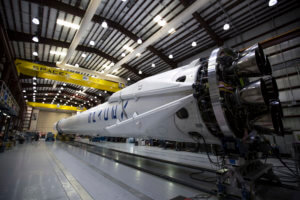PR … in SPACE!
Published on November 27, 2017, at 10:32 a.m.
by Maggie Schneider.
“Three. Two. One. And lift … off?”
For a few moments, the gathered crowd in Cape Canaveral, Florida, waited expectantly for the launch of the rocket down on the launchpad. This was slated to be the first supply mission to the International Space Station conducted by a private company. The countdown had proceeded like any other launch, but just as the engines had begun to ignite, something went wrong. The rocket was still there on the ground.
The following day, the news would be filled with pundits questioning whether a little startup company could ever join with national and international space programs such as NASA, ROSCOSMOS, ESA or JAXA. It seemed like SpaceX might have found its limit.

SpaceX remained calm. The company president, Gwynne Shotwell, joined NASA Commercial Crew and Cargo Program manager Alan Lindenmoyer to discuss the cause of the mission abort. When asked how she would respond to insinuations of failure, Shotwell simply said, “This is not a failure. We aborted with purpose. It would be a failure if we were to have lifted off with an engine trending in this direction.”
Three days later, SpaceX successfully launched its Dragon capsule to dock with the ISS. The aborted launch was forgotten, and SpaceX was lauded for making history. With careful framing and a focus on the near future, the executives at the company were able to keep their reputation from suffering too much damage. The real question is, can they keep it up?
Space exploration has always required a massive amount of public relations to garner support of programs. Presidents of the United States have made speeches on behalf of NASA that are still quoted today. Since NASA relies on government funding, its survival is centered upon public opinion and the opinions of those who represent the public. So far, NASA has done amazing work to connect with the public, even winning PRSA’s Best of Silver Anvil Award in 2017.

However, NASA is no longer the only player in this game. In the past decade, commercial space companies have developed their own plans for sending spacecraft into orbit, to the ISS, to the moon or even to Mars. These companies — SpaceX, Virgin Galactic, United Launch Alliance, Blue Origin, Sierra Nevada Corporation and Ad Astra, to name a few — partner with customers who pay for launch services. These services can be anything from sending a satellite into orbit to resupplying the ISS to eventually launching tourists and station crew members into space.
Since these organizations operate like any other business in the United States, they don’t necessarily rely as much on public support. According to Mike Wall, a writer for Space.com, this means that some companies can afford to be more sparing in their outreach.
“Generally, it makes sense for a government space agency to put more effort into PR,” Wall said. “Public interest can translate into a bigger budget. … But [private space companies] have money, so they don’t need to be as focused on messaging. Some are doing stuff that they’re not really ready to show yet, if they’re testing things that might not be working yet. Some might be working on a secret project. They have to focus on, ‘What does the customer want?’”
Though some of the commercial space companies are more secretive, others are happy to share their successes and failures with the world, all in the name of raising awareness. One of the biggest innovations is live-streaming launches online.
“There’s more and more interest [in private space], and you can trace that to SpaceX and Blue Origin,” Wall said. “When you have a video of it that people can watch live, that generates a lot of interest. We have more and more ability to see these things happen. That’s a much more powerful and exciting thing than to read about it. I think that’s happening all across the spaceflight industry. These companies are taking advantage of stuff happening. I think that’s really reaching people.”
Space exploration is an industry focused on the future, and the public relations strategies for space organizations will have to shift in order to keep up with the rapid developments. Dale Thomas, a former associate director at NASA’s Marshall Space Flight Center and current professor of systems engineering at The University of Alabama in Huntsville, warns that the first priority for PR professionals in the private space industry will need to be preparing for an inevitable crisis.
“The public has to be conditioned for failure. They look at SpaceX and Boeing the same way they look at Delta and United. Especially if there’s an early accident, it can bring their industry down, in my opinion. I believe the public has to be conditioned to understand this is a risky business. There’s going to be some loss of life,” said Thomas.
Thomas stresses that the loss of future space travelers would be tragic and is not to be taken lightly. At the same time, it should not hinder the progress of reaching the final frontier. It will be tough for the public relations professionals of both the private companies and NASA working together to prepare for both the amazing successes and devastating failures that come with any pioneering venture.
Tackling the challenges of public relations for commercial spaceflight in the future is just as exciting as developing the rockets that will take average people to the stars. If visionaries like SpaceX’s Elon Musk or Planetary Resources’ Chris Lewicki have their way, entirely new industries such as asteroid mining and businesses on Mars will be a reality in our lifetime, so PR professionals should take notice and be ready to become the communicators of the future. One day, there will be a spokesperson conducting a news conference on the surface of Mars. One day, we will need to have PR in space!




